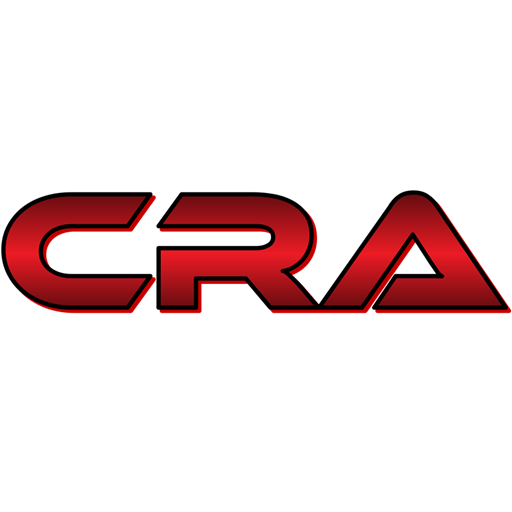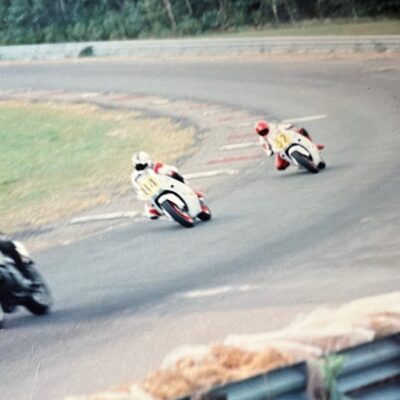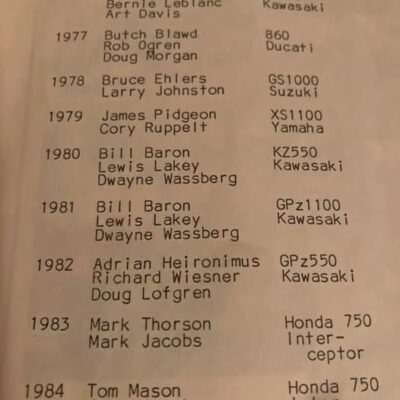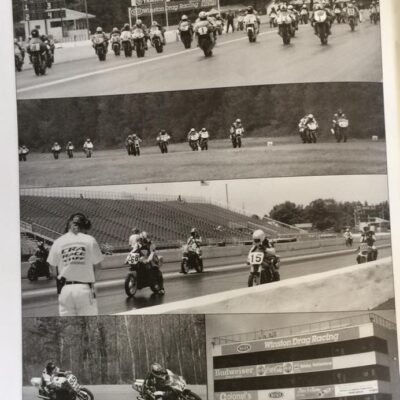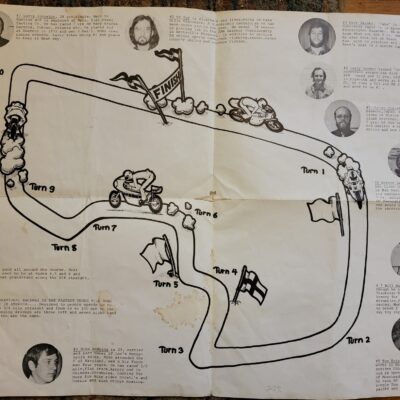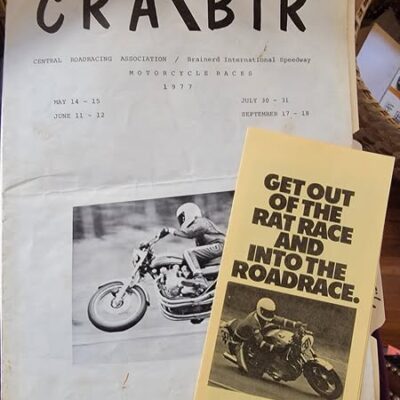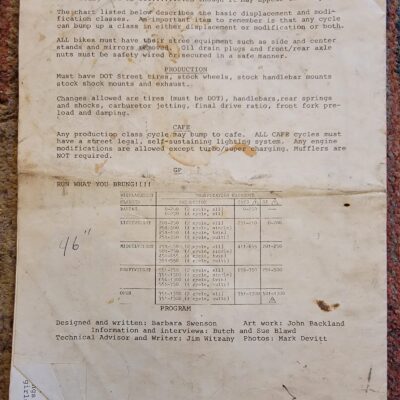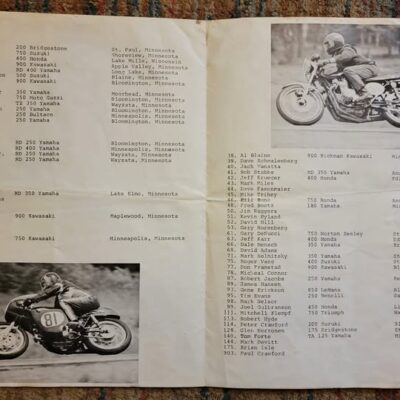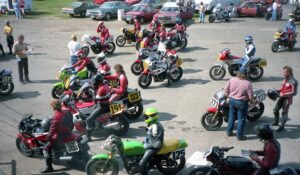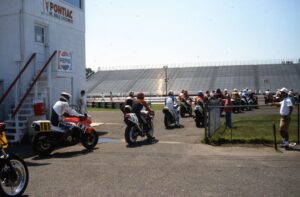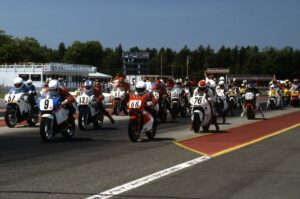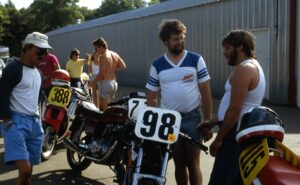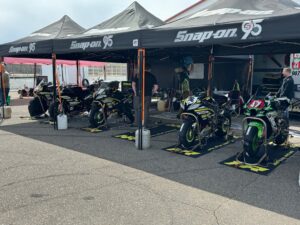1970 to Today
Do you have old photos or other artifacts from the CRA's history that you wish to contribute? Corrections to anything we have recorded? Email our Club Historian for information on how to contribute to our archives.
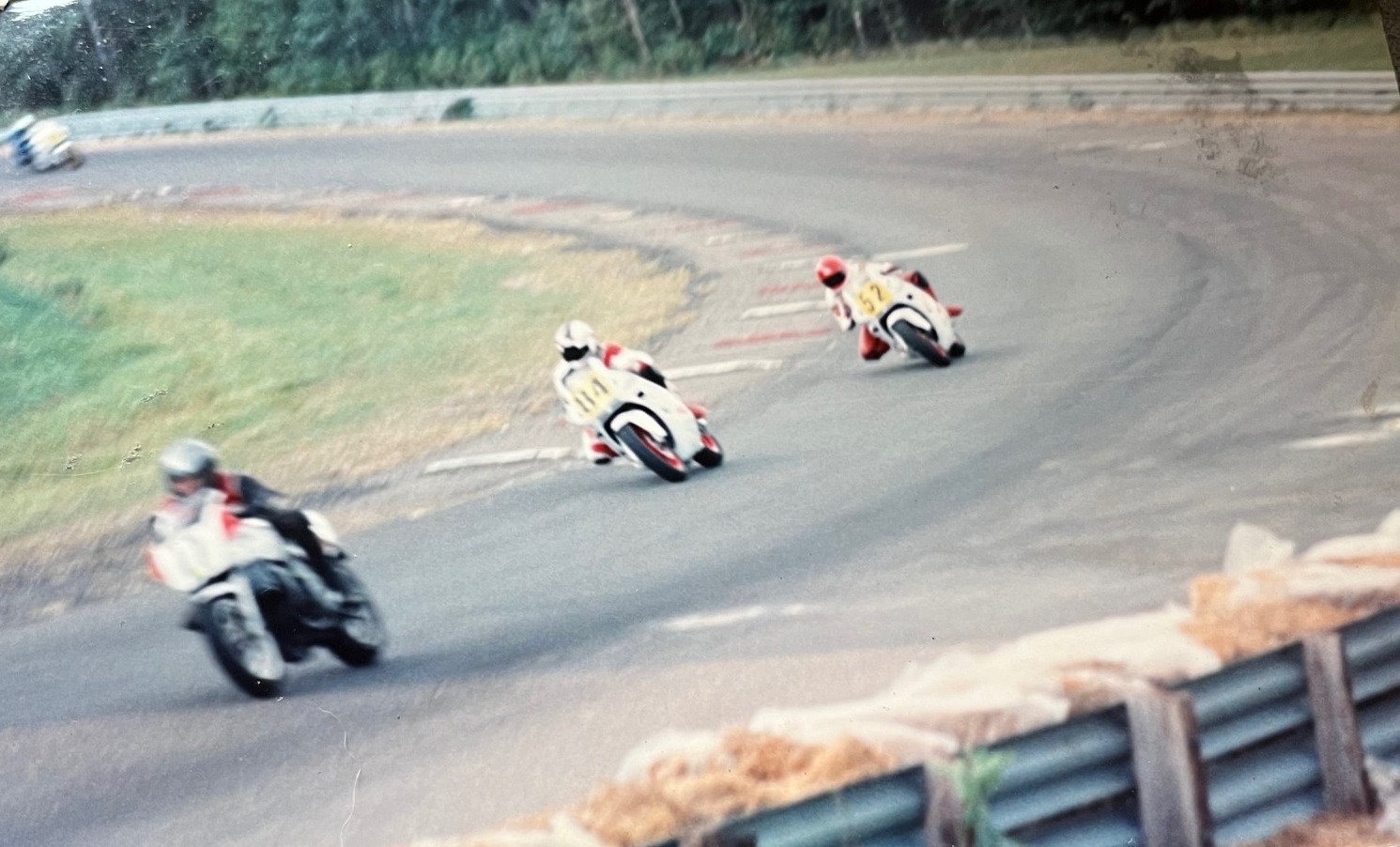
1976
1976
This year’s schedule featured five race weekends, with a new points system replacing last year’s trophy-only format (1st = 3 pts, 2nd = 2 pts, 3rd = 1 pt). Larry Johnston claimed the overall championship with 40 points, followed by Ed Key with 20. The CRA had 600 members as of October 7, with racer licenses priced at $15 for the year. The inaugural 5-hour endurance race, benefiting the Kidney Foundation’s 'Race for Life,' saw participants raising pledges per lap completed. Mark Jacobs, Bernie LeBlanc, and Art Davies took the win on a Kawasaki KZ 650, completing 123 laps. Remarkably, the winning bike was uncrated just the night before the event at Carl Eide’s shop, ridden to BIR, raced, and then ridden back to the Twin Cities.
1977
1977
A new points system, proposed and tracked by Glen Christianson, was introduced (1st = 20 pts, 2nd = 16 pts, 3rd = 13 pts, etc.). Race entry fees were set at $20 for the first race and $5 for each additional one. Full-face helmets and face shields were recommended for safety. The CRA began awarding single-digit number plates to the top nine riders, with Mark Jacobs earning the #1 plate, followed by Chris Christensen (#2) and Mitch Klempf (#3). The club was honored by the Land O' Lakes Region of the SCCA for ‘Distinguished Service.’ A potential affiliation with the AMA was discussed but ultimately declined. Don Framstad clocked the fastest straightaway speed at 134 mph via radar gun. The 5-hour endurance race was won by Butch Blawd, Rob Ogren, and Doug Morgan on a Ducati 860, completing 129 laps.
1978
1978
A typical CRA race weekend at BIR featured Friday evening camping and registration, Saturday registration, practice, and evening festivities, followed by Sunday afternoon races. The May weekend saw a dramatic incident when Larry Connor crashed in turn 9, hitting the guardrail. Fortunately, he's recovering well, but his TZ750 won't be ready for June. Racers aimed to break the 150 mph barrier and achieve 1:55 lap times—before the turn 9 ‘bus stop’ existed. Mitch Klempf (#710) averaged a 2:02.1 lap time, translating to an 89 mph average speed, with an estimated straightaway speed of 130-135 mph. Larry Johnston secured the #1 plate, with Mitch Klempf taking #2 and Chris Christensen #3. The 5-hour endurance race was won by Bruce Ehlers and Larry Johnston on a Suzuki GS 1000, completing 137 laps out of 41 entries, with 22 bikes finishing.
1979
1979
Race 2 in August saw a major challenge when Bill Bune spilled a tank of oil from turn 3 to turn 5, leaving only 10 of 27 bikes finishing. Thankfully, no serious injuries occurred. New safety regulations required Snell 75 approved helmets this year. Chris Christensen claimed the #1 plate, followed by Mark Jacobs (#2) and Mark Miles (#3). History was made with the first all-female endurance team featuring Julia Vanatta, Lynn Krotzer, and Joanne Gregg. The 5-hour endurance race was won by James Pidgeon and Cory Ruppelt on a Yamaha XS 1000, completing 143 laps.
Top 3
1976
#1 – Larry Johnston, #2 – Ed Key
1977
#1 – Mark Jacobs, #2 – Chris Christensen, #3 – Mitch Klempf
1978
#1 – Larry Johnston, #2 – Mitch Klempf, #3 – Chris Christensen
1979
#1 – Chris Christensen, #2 – Mark Jacobs, #3 – Mark Miles
1980
1980
A total of 159 racers participated in at least one race during the 1980 season. Bairn and Brian Gallagher made history as the first father-son endurance team in CRA—possibly even nationally. The season banquet saw an attendance of 199 people.
Dave Schmallenberg earned the #1 plate, with Dwayne Wassberg taking #2 and Paul Curtis #3.
The 5-hour endurance race was won by Bill Baron, Lewis Lakey, and Dwayne Wassberg on a Kawasaki KZ 550, completing 118 laps. Out of 51 teams that started, more than 30 finished.
1981
1981
The season featured three racing categories: Production (stock bikes with minor modifications), Café (superbike), and Grand Prix (open modifications, including turbo-charging). CRA teamed up with WERA for the May event, and a new points system was introduced (15, 12, 10, 8, 6, 5, 4...1).
To maximize track time, cool-off laps were eliminated, allowing for eight sprint races per weekend. The “Put Bairn Gallagher Back to Stock” raffle was held to support Bairn after his severe July crash in turn 2, which resulted in multiple injuries, including broken legs and ribs.
The endurance race featured a Le Mans-style start, with headlights required for the final hour. Dave Schmalenberg secured the #1 plate, followed by Dwayne Wassberg (#2) and John Waldoch (#3).
The 5-hour endurance race was won by Bill Baron, Lewis Lakey, and Dwayne Wassberg on a Kawasaki GPZ 1100, completing 142 laps.
1982
1982
Dave Schmalenberg led the new riders' seminar on April 17. The season featured 100-mile trophy dashes, covering 33 laps each. On July 3rd, John Kocinski (#46) claimed first place in both Race 1 events for showroom stock/production and Grand Prix. Adrian Heironimus secured the #1 plate, followed by Mert Moore (#2) and Dave Fraser (#3). The 5-hour endurance race was won by Adrian Heironimus, Dick Wiesner, and Doug Lofgren on a Kawasaki GPZ 550, completing 140 laps—one of four teams to reach this milestone. The #38 team of John Roswick, Kurt Mosher, and Roger Hendricks finished 3rd in the E Production class.
1983
1983
Tragedy struck the CRA community in 1983 with the loss of Adrian Heironimus, the 1982 #1 plate holder, who was killed by a drunk driver on May 29 while returning home from a race in St. Louis. It was proposed to retire his race number (#36) at the end of the season, and the March of Dimes approved renaming the 5-hour endurance race in his honor as an annual memorial event. Further heartbreak came during the 5-hour endurance race on August 13, when racer Sarah Goodin lost her life after being struck from behind while exiting the pit lane. New or slow riders were identified with an 'X' on their backs. Chris Helland secured the #1 plate, followed by Todd Strang (#2) and Tom Mason (#3). The 5-hour endurance race was won by Mark Thorson and Mark Jacobs on a Honda 750 Interceptor, completing 140 laps. The #38 team of John Roswick and Roger Hendricks finished 2nd in the C Production class.
1984
1984
New rule: New racers MUST attend a training seminar before being allowed on track. Riders meetings will be MANDATORY!! People that have not raced for two or more seasons will be required to attend new rider training sessions. Broad paint stripes added to mark pit entrance and exit lanes to prevent further mishaps and near misses - drive across them and you’re thru racing for the weekend. More stringent requirements for obtaining a CRA competition license. 65 people in May new rider school. Cones now used to indicate starting rows. Tragedy strikes again when Kevin Earl Phifer - 3/3/59 - 6/9/84 (#75) from Grand Rapids dies in turn 1 due to oil spill on track. New riders will run a short race of their own following their training sessions. Letter received by the board from racer #102: This letter is to announce my retirement, from roadracing in general, and from BIR in particular. The reason for this is that I feel BIR is too dangerous for all riders. The front straight from corner 10 to corner 3 in particular. The layout of the track is partly to blame for this, being designed and built 15 or so years ago. But the other reason is that today’s bikes have become just too damn fast and the riders are paying the price. That price is not worth it to me any more... Steve Olson wins #1 plate, Steve Kluge #2, Bill Young #3. 5 hour endurance won by Bryon Lambert, Tom Mason and John Jacobs aboard a Honda V45 750 Interceptor.
1985
1985
The CRA board agreed to affiliate with CCS this season. The April new rider seminar saw 60 students participate. A proposal to introduce Expert and Novice classifications was put forward. Bonnie and Don Framstad welcomed their baby girl, Andrea Rose, on July 23, 1985. A 1969 BSA, donated by Fred Down, was raffled during the 5-hour endurance event, with proceeds benefiting the March of Dimes. The proposed introduction of a blue flag was rejected. Tom Mason secured pole position at the AMA National (Superbike), marking a notable achievement. This year also marked the final running of the 'Race for Life' endurance event. A new points system was implemented, awarding 15 points for 1st, 12 for 2nd, followed by 10, 8, 6, 5, 4, 3, 2, and 1 for all other finishers. Todd Strang earned the #1 plate, followed by Wes Wickland (#2) and Glen Christianson (#3). The 5-hour endurance race was won by Dave Fraser and Frank Hershman on a Yamaha FZ 750
Top 3
1980
#1 -Dave Schmallenberg, #2 – Dwayne Wassberg, #3 – Paul Curtis
1981
#1 – Dave Schmalenberg, Dwayne Wassberg, #3 – John Waldoch
1982
#1 – Adrian Heironimus, #2 – Mert Moore, #3 – Dave Fraser.
1983
#1 – Chris Helland, #2 – Todd Strang, #3 – Tom Mason
1984
#1 – Steve Olson, #2 – Steve Kluge, #3 – Bill Young
1985
#1 – Todd Strang, #2 – Wes Wickland, #3 – Glen Christianson.
- Introduction of 500cc Era: The 1970s saw the dominance of 500cc Grand Prix racing, with legends like Giacomo Agostini and Barry Sheene.
- Two-Stroke Revolution: Shift from four-stroke to more powerful two-stroke engines, revolutionizing GP racing.
- Isle of Man TT Departure: The Isle of Man TT was removed from the Grand Prix calendar in 1977 due to safety concerns.
- Japanese Manufacturer Dominance: Honda, Yamaha, and Suzuki emerged as dominant forces in world championship racing.
- Rise of Barry Sheene: Sheene became a global icon, winning 500cc world titles in 1976 and 1977.
- Daytona 200 Prestige: The Daytona 200 grew in prominence, attracting top international riders and factory teams.
- Disco & Rock Music: Disco boom with artists like Bee Gees; rise of punk and rock legends like Led Zeppelin.
- Blockbuster Films: Jaws and Star Wars revolutionized Hollywood.
- Women’s Liberation: Feminist movement pushed for equal rights; Roe v. Wade legalized abortion.
- Environmentalism: Earth Day (1970) sparked environmental awareness and legislation.
- Political Scandals: Watergate led to Nixon’s resignation; Vietnam War ended.
- Tech & Gaming: Apple II and Atari’s Pong marked the digital age’s rise.
